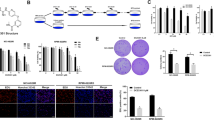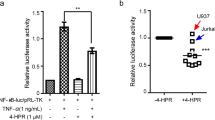Abstract
Most patients with multiple myeloma (MM) will relapse eventually due to the acquired multidrug resistance (MDR). The objective of this study was to explore the reversal effect of curcumin on the MDR of human MM cell line, MOLP-2/R, and analyze the role of Fanconi anemia (FA)/BRCA pathway in this process. MOLP-2/R was selected by stepwise exposure of parental MOLP-2 cells to increasing concentrations of melphalan. The MTT assay was used to detect the reversal ratio of curcumin. The FANCD2 monoubiquitination expression was detected by western blotting to explore the role of FA/BRCA pathway. Cell cycle, apoptosis, and intracellular drug concentration were analyzed by flow cytometry. The results indicated that combination of melphalan with curcumin had stronger effects on the proliferation inhibition, inducement of apoptosis, G2/M phase arrest, and enhancement of intracellular drug concentration than melphalan alone in MOLP-2/R cells. These effects were accompanied with inhibition of FA/BRCA pathway by down regulation of FANCD2 protein monoubiquitination in a dose-dependent manner. In conclusion, curcumin reversed multidrug resistance of MOLP-2/R through inhibition of FA/BRCA pathway. The possible mechanisms include (1) reduction of DNA damage repair and stimulation of apoptosis of tumor cells through inhibition of FA/BRCA pathway, which is important for DNA repair, and (2) achievement of high concentration in target cells. Curcumin may be a safe reversal agent of multidrug resistance with low-dose DNA cross-linking agents.


Similar content being viewed by others
References
Yang HH, Ma MH, Vescio RA et al (2003) Overcoming drug resistance in multiple myeloma:the emergence of therapeutic approaches to induce apoptosis. J Clin Oncol 21:4239–4247
Kumar V, Varma N, Varma S et al (2004) Flow cytometric analysis of DNA indices, expression of p53 and multidrug resistance genes in multiple myeloma patients. Anal Quant Cytol Histol 26:271–277
Tai YT, Teoh G, Lin B et al (2000) Ku86 variant expression and function in multiple myeloma cells is associated with increased sentivity to DNA damage. J Immunol 165:6347–6355
Efferth T, Fabry U, Osieka R (2002) Interleukin-6 affects melphalan-induced DNA damage and repair in human multiple myeloma cells. Anticancer Res 22:231–234
Mathew CG (2006) Fanconi anaemia genes and susceptibility to cancer. Oncogene 25:5875–5884
Taniguchi T, Tischkowitz M, Ameziane N et al (2003) Disruption of the Fanconi anemia-BRCA pathway in cisplatin-sensitive ovarian tumors. Nat Med 9:568–574
Hannemann J, Oosterkamp HM, Bosch CA et al (2005) Changes in gene expression assiociated with response to neoadjuvant chemotherapy in breast cancer. J Clin Oncol 23:3331–3342
Mori H, Niwa K, Zheng Q et al (2001) Cell proliferation in cancer prevention; effects of preventive agents on estrogen-related endometrial carcinogenesis model and on an in vitro model in human colorectal cells. Mutat Res 480:201–207
Aggarwal BB, Kumar A, Bharti AC (2003) Anticancer potential of curcumin: preclinical and clinical studies. Anticancer Res 23:363–398
Ruffin MT, Normolle DP, Heath DD et al (2003) Dose escalation of curcumin in healthy adults. Cancer Epidem Biomar Prevent 12(Part 2 Suppl. S):1324S
Sharma RA, Euden SA, Platton SL et al (2004) Phase I clinical trial of oral curcumin: biomarkers of systemic activity and compliance. Clin Cancer Res 10:6847–6854
Garcea G, Berry DP, Jones DJL et al (2005) Consumption of the putative chemopreventive agent curcumin by cancer patients: assessment of curcumin levels in the colorectum and their pharmacodynamic consequences. Cancer Epidem Biomar Prevent 14:120–125
Shi YQ, Qu XJ, Liao YX et al (2008) Reversal effect of a macrocyclic bisbibenzyl plagiochin E on multidrug resistance in adriamycin-resistant K562/A02 cells. Eur J Pharmacol 14:66–71
Wang J, Xia Y, Wang H et al (2007) Chinese herbs of Shenghe Powder reverse multidrug resistance of gastric carcinoma SGC-7901. Integr Cancer Ther 6:400–404
Dronkert ML, Kanaar R (2001) Repair of DNA interstrand cross-links. Mutat Res 486:217–247
Nobili S, Landini I, Giglioni B et al (2006) Pharmacological strategies for overcoming multidrug resistance. Curr Drug Targets 7:861–879
Di Nicolantonio F, Mercer SJ, Knight LA (2005) Cancer cell adaptation to chemotherapy. BMC Cancer 5:78
D’Andrea AD, Grompe M (2003) The Fanconi anemia/BRCA pathway. Nat Rev Cancer 3:23–34
Sasaki MS, Takata M, Sonoda E et al (2004) Recombination repair pathway in the maintenance of chromosomal integrity against DNA interstrand crosslinks. Cytogenet Genome Res 104:28–34
Song XR, Hou SX (2005) Research progress in the reversion of traditional Chinese medicine on multidrug resistance of tumor. China J Chin Materia Medica 30:1300–1304
Shankar S, Ganapathy S, Chen Q et al (2008) Curcumin sensitizes TRAIL-resistant xenografts: molecular mechanisms of apoptosis, metastasis and angiogenesis. Mol Cancer 29:16
Choi BH, Kim CG, Lim Y et al (2008) Curcumin down-regulates the multidrug-resistance mdr1b gene by inhibiting the PI3K/Akt/NF kappa B pathway. Cancer Lett 259:111–118
Dhandapani KM, Mahesh VB, Brann DW (2007) Curcumin suppresses growth and chemoresistance of human glioblastoma cells via AP-1 and NFkappaB transcription factors. J Neurochem 102:522–538
Limtrakul P (2007) Curcumin as chemosensitizer. Adv Exp Med Biol 595:269–300
Chan MM, Fong D, Soprano KJ et al (2003) Inhibition of growth and sensitization to cisplatin-mediated killing of ovarian cancer cells by polyphenolic chemopreventive agents. J Cell Physiol 194:63–70
Garcea G, Berry DP, Jones DJ et al (2005) Consumption of the putative chemopreventive agent curcumin by cancer patients: assessment of curcumin levels in the colorectum and their pharmacodynamic consequences. Cancer Epidemiol Biomark Prev 14:120–125
Garcea G, Jones DJ, Singh R et al (2004) Detection of curcumin and its metabolites in hepatic tissue and portal blood of patients following oral administration. Br J Cancer 90:1011–1015
Sharma RA, Euden SA, Platton SL et al (2004) Phase I clinical trial of oral curcumin: biomarkers of systemic activity and compliance. Clin Cancer Res 10:6847–6854
Sharma RA, McLelland HR, Hill KA et al (2001) Pharmacodynamic and pharmacokinetic study of oral Curcuma extract in patients with colorectal cancer. Clin Cancer Res 7:1894–1900
Acknowledgments
Thanks for great support and help of Hans Joenje, Najim Ameziane, Martin Rooimans, Anneke Oostra, and Johan P. de Winter (Department of Human Genetics, Free University, Amsterdam).
Author information
Authors and Affiliations
Corresponding author
Electronic Supplementary Material
Below is the link to the electronic supplementary material.
ESM 1
(PDF 271 kb)
Rights and permissions
About this article
Cite this article
Xiao, H., Xiao, Q., Zhang, K. et al. Reversal of multidrug resistance by curcumin through FA/BRCA pathway in multiple myeloma cell line MOLP-2/R. Ann Hematol 89, 399–404 (2010). https://doi.org/10.1007/s00277-009-0831-6
Received:
Accepted:
Published:
Issue Date:
DOI: https://doi.org/10.1007/s00277-009-0831-6




